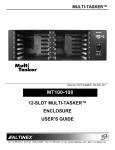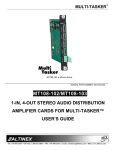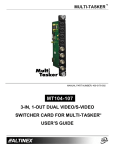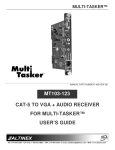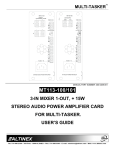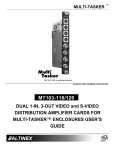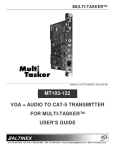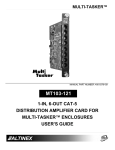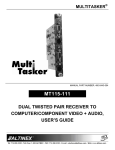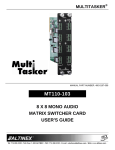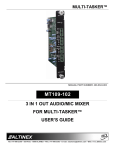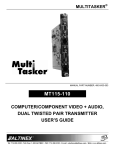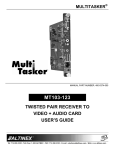Download Altinex MT108-105 Network Card User Manual
Transcript
MULTI-TASKER MT108-104 is shown above. MANUAL PART NUMBER: 400-0178-002 MT108-104/MT108-105 4-IN, 4-OUT STEREO AUDIO LINE DRIVER CARDS FOR MULTI-TASKERTM USER’S GUIDE MULTI-TASKER TABLE OF CONTENTS Page PRECAUTIONS / SAFETY WARNINGS .............. 2 1.1 GENERAL ................................ .................. 2 1.2 INSTALLATION ................................ .......... 2 1.3 CLEANING ................................ ................. 2 1.4 FCC / CE NOTICE................................ ...... 2 ABOUT YOUR MT108-104/(105)......................... 3 TECHNICAL SPECIFICATIONS .......................... 3 DESCRIPTION OF MT108-104/(105).................. 4 APPLICATION DIAGRAM................................ .... 4 INSTALLING YOUR MT108-104/(105)................ 6 OPERATION................................ ........................ 6 7.1 RS-232 CONTROL................................ .... 6 7.2 DESCRIPTION OF COMMANDS .............. 6 7.3 SUMMARY OF COMMANDS..................... 9 TROUBLESHOOTING GUIDE............................. 9 8.1 LED IS NOT LIT ................................ ........ 9 8.2 NO SOUND ................................ ............... 9 8.3 SOUND DISTORTION............................. 10 8.4 SOUND LEVEL IS LOW.......................... 10 ALTINEX POLICY................................ .............. 10 1 MULTI-TASKER PRECAUTIONS / SAFETY WARNINGS interference operation. 1 Please read this manual carefully before using your MT108-104/(105) Line Driver. Keep this manual handy for future reference. These safety instructions are to ensure the long life of your MT108-104/(105) and to prevent fire and shock hazard. Please read them carefully and heed all warnings. Handle the MT108-104/(105) carefully. Dropping or jarring can damage the card. • Do not pull the cables that are attached to the MT108-104/(105). • Insert the card carefully into the slots of the Multi-Tasker™ without bending any edges. • When removing a card, please make sure that the expansion card to which it is attached is also pulled out simultaneously. 1.3 CLEANING • Clean only the connector area with a dry cloth. Never use strong detergents or solvents, such as alcohol or thinner. Do not use a wet cloth or water to clean the card. Do not clean or touch any component or PCB. 1.4 FCC / CE NOTICE • This device complies with part 15 of the FCC Rules. Operation is subject to the following two conditions: (1) This device may not cause harmful interference, and (2) this device must accept any interference received, including 2 undesired • Any changes or modifications to the unit not expressly approved by ALTINEX, Inc. could void the user’s authority to operate the equipment. Qualified ALTINEX service personnel, or their authorized representatives must perform all service. 1.2 INSTALLATION • cause This equipment has been tested and found to comply with the limits for a Class A digital device, pursuant to Part 15 of the FCC Rules. These limits are designed to provide reasonable protection against harmful interference when the equipment is operated in a commercial environment. This equipment generates, uses, and can radiate radio frequency energy and, if not installed and used in accordance with the instruction manual, may cause harmful interference to radio communications. Operation of this equipment in a residential area is likely to cause harmful interference in which case the user will be required to correct the interference at his own expense. • To prevent fire or shock, do not expose this unit to rain or moisture. Do not place the MT108-104/(105) in direct sunlight, near heaters or heat radiating appliances, or near any liquid. Exposure to direct sunlight, smoke, or steam can harm internal components. may • 1.1 GENERAL • that MULTI-TASKER ABOUT YOUR MT108-104/(105) 2 TECHNICAL SPECIFICATIONS MT108-104/(105) 4-in 4-out Stereo Audio Line Driver Cards FEATURES/DESCRIPTION GENERAL Inputs 3 MT108-104/(105) 4 Four 3.5mm stereo mini Input Connector Female audio jacks Outputs 4 Four 3.5mm stereo mini Output Connector Female audio jacks Compatibility Stereo Audio Table 1. MT108-104/(105) General The MT108-104/(105) is a Stereo Audio Line Driver Card designed for use with the MultiTasker system. When installed in a MultiTasker, this card allows the connection of four stereo audio sources to four receiving devices, which can include cassette recorders, mixers, and/or amplifiers for sound reinforcement systems. MECHANICAL MT108-104/(105) Enclosure Slots Required One Weight 1.0 lb. (0.45 kg) Connector Panel Black T° Operating 10°C-40°C T° Maximum 0 to 50°C Humidity 90% non-condensing MTBF (calc.) 45,000 hrs Table 2. MT108-104/(105) Mechanical These cards are ideal for distributing audio to recording devices in dubbing racks using simple off-the-shelf cables. As an example, the MT108104/(105) can distribute audio to four cassette recorders or it can handle the audio portion of A/V distribution to four VCRs. As a “transparent” line driver, these cards utilize AC coupling on their inputs for ideal signal transfer characteristics. The power indicator on the card is a red LED indicating the board has power applied. These cards consume one slot each. ELECTRICAL MT108-104/(105) Input Signals Max Level 0 dBu Impedance 600 Ohms Audio Throughput Gain 0 dB Frequency Response 10Hz to 20kHz (+/- 0.05 dB) Noise Floor -100 dB @ 20 kHz CMRR >80 dB, 10 Hz to 20 kHz Output Signals Level, Each Channel 1V p-p Impedance 600 Ohms Gain 0 dB Power Power from Power +6V -6V +13V -13V MT100-100 Consumption MT108-104 15mA 30mA 20mA 0.74 watts MT108-105 20mA 45mA 35mA 1.04 watts Table 3. MT108-104/(105) Electrical 3 MULTI-TASKER DESCRIPTION OF MT108-104/(105) 4 APPLICATION DIAGRAM Application 1 4 5 MULTI-TASKER Application Diagram 2: Internal View of the MT108-104/(105) 5 MULTI-TASKER INSTALLING YOUR MT108-104/(105) 6 Step 1. Slide the MT108-104/(105) into an available slot in the Multi-Tasker™ Basic Enclosure in order to connect to the bus. Make sure that the MT108-104/(105) card fits into place. Secure the card to the Multi-Tasker™ by tightening the retainer screws located on the top and bottom of the MT108-104/(105) card. Square brackets “[ command. ]” are part of the 2. Use uppercase letters for all commands. 7.2 DESCRIPTION OF COMMANDS Each command consists of three parts: function, card ID, and unit ID. [Function, Card ID, Unit ID]. Example: Step 2. The LED on the card panel will turn red indicating that the card is in full operation. An LED that is blinking red indicates that the card is experiencing a problem. If the LED is blinking, see the Troubleshooting Guide in section 8. [VERC3U2] VER = function C3 = Card ID U2 = Unit ID For detailed information regarding function, see each command description. Step 3. Connect an audio cable from the audio source to an available input connector (4 inputs) of the MT108-104/(105). Connect any or all of the four available outputs of the MT108-104/(105) to audio equipment. Card ID is an assigned value from 1 to 19, (1 to 8 or 1 to 4 depending on which enclosure is being used); based on which slot the card is in. Card ID 0 (C0) is used for the controller (see user’s guide for the MT100-100). Changing the position of a card will significantly affect the commands recorded on software definitions or a third party control system. Step 4. Starting from the left, identify the slot number where the MT108-104/(105) card is plugged into the Enclosure and note that it is for RS-232 control. OPERATION 1. Unit ID has a value from 0 to 9. Unit ID 0 should be used for single unit operation. If the Unit ID is set to 0, then each command can be used without Ui (use command [SETU0]; see user’s guide for the MT100-100). 7 7.1 RS-232 CONTROL The outputs of the MT108-104 card are always enabled; therefore, no RS-232 control is necessary. Example: [VERC3]: for unit ID zero [VERC3Ui]: for unit ID other than zero [VERC3]: equivalent to [VERC3U0] When used in the Multi-Tasker™ Basic Enclosure, the MT108-105 has many advanced remote control capabilities, which are accessible through a standard RS-232 communication. The actual control may be accomplished using a computer control system or any other device capable of sending RS-232 commands. 1. [VER] This command displays the software version and card type of the MT108-105 card. Command Format: VERCnUi 7.1.1 RS-232 INTERFACE Cn = card ID number (n = # from 1 to 19) (1-8 for MT100-101 or 1-4 for MT100-106) The RS-232 commands for the MT108-105 are in a simple ASCII character format. Ui = Unit ID (i = # from 0 to 9) (refer to the MT100-100 user’s guide for explanation) 6 MULTI-TASKER Example: S = save configuration If one MT108-105 card is plugged in slot #2 of unit 3: If Outputs 1 and 2 are at volume level 16 and outputs 3 and 4 are at level 8, the feedback after sending the command [C4S], for slot 4, would be: Send the command [VERC2U3], and the Multi-Tasker™ Basic Enclosure will return the following feedback: Vol1=16/16 Vol2=16/16 Vol3=8/16 Vol4=8/16 MT108-105 690-0127-007 690-0127-007 = software version MT108-105 = card type: MT108-105 Card Status Saved 2. [C] 4. [ + ] or [ - ] This command receives the status of the card. This command increases or decreases volume. It immediately follows the [SEL] command. Any command other than [ + ] or [ - ] will reset the previous selection and the [SEL] command will need to be reissued. Command Format: [CnUi] Cn = card ID (n = from 1 to 19) (1-8 for MT100-101 or 1-4 for MT100-106) Ui = unit ID (i = from 0 to 9) (refer to the MT100-100 user’s guide for explanation) Example: Example: If the status of audio card 2 of unit zero is as follows: If one MT108-105 card is plugged in slot #2 of unit 3, sending the [C2U3] command, the Multi-Tasker™ Basic Enclosure will return feedback as: Vol1=16/16 Vol2=0/16 Vol3=0/16 Vol4=0/16 Vol1=16/16 Vol2=12/16 Vol3=8/16 Vol4=4/16 Send the commands: [SEL1C2] [ - ] [ - ] [SEL2C2] [ + ] [ + ] [C2] There are 16 levels for amplitude. In the above example, Input 1 (Vol1) is at level 16 out of 16 or maximum amplitude. Input 2 is at 12 or ¾ amplitude. Input 3 is at ½ volume and Input 4 is at ¼ volume. The new status will be as follows: Vol1=14/16 Vol2=2/16 Vol3=0/16 Vol4=0/16 If there is no card plugged into slot #2 of unit 3, the Multi-Tasker™ Basic Enclosure will not return any feedback. Note: The [SEL], [ + ], and [ - ] commands can also be used to control the volume for a group of cards. 3. [CiS] Command Format: [SELmGkUi] This command saves the current status of the card's output volume configuration. This configuration will be restored after system is reset or powered off then on. SELm = select output (m = from 1 to 4) Gk = group number (k = # from 1-9) Ui = unit id (i = # from 0-9) Ci = card number 7 MULTI-TASKER needed for execution. Insert a 200ms delay [WAIT] time after sending this command. Example: If cards 1, 2, and 3 are grouped as group 5 of unit 1, send the command [SEL1G5U1]. Then send the commands [ + ], and [ - ] to increase or decrease the volume for cards 1, 2, and 3 simultaneously. [CLRCnUi] Cn = card ID No. (n = slot # from 1 to 19) (1-8 for MT100-101 or 1-4 for MT100-106) Ui = Unit ID number (i = 0 to 9) 5. [SEL] After [CLR] is executed, send [Cn] and receive feedback as: This command selects the individual input for adjusting the volume level of each output. Vol1=16/16 Vol2=16/16 Vol3=16/16 Vol4=16/16 Command Format: [SELmCnUi] SELm = volume select for output m. (m = 1-4) Cn = card ID (n = from 1 to 19) (1-8 for MT100-101 or 1-4 for MT100-106) 8. […S] – Save Ui = unit ID (i = from 0 to 9) This command will save the volume configuration command being sent in memory. When sending the command [VOL1A10C4S], after reset or power up, the volume level of output 1 on C4 will be level 10. After the [SEL] command is executed, the [ + ] and [ - ] commands must be executed immediately in order to increase or decrease the volume. Any other command (or an empty command such as [ ] ) will terminate the [SEL] command. 9. [CLR] - Group This command clears the members for all nine groups. 6. [VOL] This command allows the Multi-Tasker to send an absolute volume level to the MT108-105. [CLRGkUi] Gk = group number (k = # from 1-9) Command Format: [VOLmAnCi] Ui = unit number (i = # from 0-9) VOLm = output select (m = 1 to 4) Example: An = amplitude level (n = 0 to 16) a) To clear group #1, send the command [CLRG1U1]. This command clears the members for the specified group only. b) To clear all groups of unit 1, send the command [CLR G[U1]. Ci = card ID (i = from 1 to 19) (1-8 for MT100-101 or 1-4 for MT100-106) Ui = unit ID (i = from 0 to 9) Example: 10. [WR] If there is an MT108-105 card in Slot 4 of Unit 0, sending the command [VOL1A16C4] will set the volume of output 1 to the maximum level of 16. This command groups multiple cards in the MT100-100 Enclosure. Each unit contains a maximum of nine groups. Command Format: [WRCn…GkUi] 7. [CLR] - Card Cn = card ID No. (n = slot # from 1 to 19) (1-8 for MT100-101 or 1-4 for MT100-106) The command clears all volumes to maximum for a single card. With this command, 200ms is Gk = group number (k = # from 1-9) 8 MULTI-TASKER Ui = unit number (i = # from 0-9) TROUBLESHOOTING GUIDE Example: We have carefully tested and have found no problems in the supplied MT108-104/(105); however, we would like to offer suggestions for the following: To group cards #1, 2, and 3 as group 5 of unit #1, send the command [WRC1C2C3G5U1]. After executing this command, cards 1, 2, and 3 of unit 1 will be grouped together as group 5. 8 • 8.1 LED IS NOT LIT • 8.2 NO SOUND 11. [RD] • 8.3 SOUND DISTORTION • 8.4 SOUND LEVEL IS LOW This command displays the members in each group. 8.1 LED IS NOT LIT Command Format: [RDGkUi] Cause 1: Card cage is not plugged in. Gk = group number (k = # from 1-9) Solution: Ui = unit number (i = # from 0-9) member = C1 - C19 (card 1 to 19) Plug card cage in. If the LED lights, the problem is solved. If the LED is still not lit, see Cause 2. Example: Cause 2: Card is not plugged in all the way. To read member data for group 1 of unit 1, send the [RD] command. The system will return feedback as C1C2C3 G5U1. Solution: Cause 3: Card cage slot has a problem. Solution 1: Test the card in other slots of the card cage. If the slot was damaged, the card may work in other slots. If other slots work and the LED lights, the problem is the card cage slot. The card cage may require service. Call ALTINEX at (714) 990-2300. If the other slots do not work and the LED is still not lit, see Solution 2. 7.3 SUMMARY OF COMMANDS 1) [VER] Receives software version 2) [C] Receives status of the card 3) [CiS] Saves current status of the card 4) [+] [-] Increases or decreases volume (executed immediately after the [SEL] command) 5) [SEL] Selects the volume individual output for 6) [VOL] Groups multiple cards 7) [CLRC] Clears a single group or multiple groups 8) [CLRG] Clears a group 9) [..S] Push the card in all the way. If the LED is still not lit, see Cause 3. Solution 2: Take any other known good card with an LED and verify that the slot used is good by seeing if the other card’s LED lights in that slot. If it lights, then the original card may be the source of the problem. Call ALTINEX at (714) 990-2300. each 8.2 NO SOUND Save volume being sent Cause 1: The source has a problem. 10) [WR] Groups multiple cards Solution: 11) [RD] Displays members in each group 9 Check the source and make sure that it is working at an appropriate volume level and all source connections are correct. If the MULTI-TASKER source is working and there is still no sound, see Cause 2. 8.4 SOUND LEVEL IS LOW Cause 1: The volume inappropriate. Cause 2: The card output is turned OFF. Solution 1: Turn ON the card output that is used. See RS-232 accessible commands in section 7. If no sound is present, see Solution 2. Solution: are Solution 1: Turn up the source volume. If sound level is still low, see Solution 2. Solution 2: Turn up the destination amplifier volume. If the sound level is still low, see Cause 2. Solution 2: If there is still no sound, see Cause 3. Cause 3: Cable connections to destination are incorrect. levels Cause 2: Poor signal transmission. the Make sure that cables are connected properly. Also, make sure that the continuity and wiring are good. If there is still no sound present, see Cause 4. Cause 4: The destination amplifier has a problem. Solution: Check the cables for continuity and make sure that connections are wired properly to verify that there is good signal transmission. NOTE: Test the system by removing the MT108-105 card from between the source and the destination amplifier. If problem persists, call ALTINEX at (714) 990-2300. Solution 1: Make sure that the destination amplifier is powered. If there is still no sound, see Solution 2 ALTINEX POLICY Solution 2: Set the volume of the destination amplifier to a reasonable level. If there is still no sound, call ALTINEX at (714) 990-2300. 9.1 LIMITED WARRANTY / RETURN POLICY Please see the Altinex website at www.altinex.com for details on warranty and return policy. 8.3 SOUND DISTORTION Cause 1: The source level is above 1V p-p. Solution: 9 9.2 CONTACT INFORMATION Make sure that the source level is below 1V p-p. If the sound is still distorted, see Cause 2. ALTINEX, INC 592 Apollo street Brea, CA 92821 USA Cause 2: The destination amplifier provides excessive amplification. TEL: 714 990-2300 Solution 1: Make sure that the source level is high enough so the destination amp does not have to provide excessive amplification thereby distorting the signal. If there is still sound distortion, see Solution 2. TOLL FREE: 1-800-ALTINEX WEB: www.altinex.com E-MAIL: [email protected] Solution 2: Call ALTINEX at (714) 990-2300. 10











